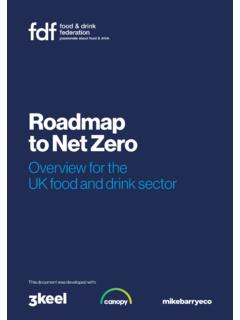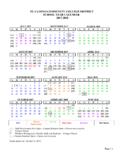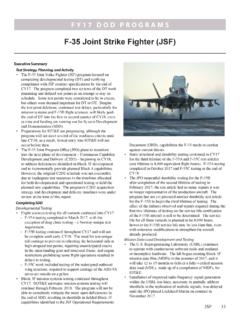Transcription of Update on F-Gas Regulation and Refrigerants July …
1 Update on F-Gas Regulation and Refrigerants july 2017 This paper provides information for users of refrigeration and air-conditioning systems in the food and drink manufacturing sector. It includes updates and reminders on key aspects of the EU F-Gas Regulation and comments on the future of the regulations post the UK leaving the EU in March 2019. Background Many refrigeration and air-conditioning (RAC) systems used in the food and drink manufacturing sector use HFC Refrigerants . The most commonly used HFCs are R-404A, R-134a and R-410A. These Refrigerants all have a very high global warming impact if they are released to the atmosphere ( a 1 kg release of R-404A is equivalent to 3922 kg of CO2).
2 The 2014 EU F-Gas Regulation (517/2014) controls the use of fluorinated greenhouse gases in Europe and it has significant impacts for users of HFC Refrigerants . Owners of RAC systems located in the EU (including the UK) need to ensure that their existing systems are in compliance with the F-Gas Regulation and that the Regulation is taken into account when selecting Refrigerants for new equipment. In October 2016 international controls on the use of HFCs were put in place via the Montreal Protocol these will lead to a global phase-down in HFC use. Key Aspects of the EU F-Gas Regulation The FDF has previously circulated detailed guidance on the EU F-Gas Regulation . This short article is intended to highlight some of the most important aspects of the F-Gas Regulation .
3 For food and drink manufacturers the key issues are as follows: HFC phase-down the 2018 big cut The quantity of HFCs that can be placed on the EU market will be cut in a series of steps as illustrated in Figure 1. By 2030, only 20% of the quantity of HFCs that were sold in 2015 will be available. The HFC phase-down is the most crucial aspect of the F-Gas Regulation and will have a major influence on use of Refrigerants in all end use markets including food and drink manufacturing. The first really big cut in HFC supply comes in 2018 when there will be a cut of around 40%. It is likely that HFC refrigerant prices will rise sharply in 2017 / 2018 as there is potential for a significant refrigerant shortage.
4 The phase-down is based on GWP-weighted quantities of HFCs. GWP is the global warming potential of a substance. The adjacent table illustrates the GWP of various Refrigerants . During the HFC phase-down it will be important to avoid using the Refrigerants with the highest GWPs such as R-404A. The advantages of using ultra-low GWP Refrigerants such as ammonia, CO2 or the recently introduced HFOs1 ( R-1234ze) are self-evident. For existing HFC refrigeration plants it is important to avoid leakage this will reduce your demand for HFCs. When buying new equipment, you must avoid very high GWP Refrigerants and, where possible, move to the ultra-low GWP options. 1 HFO: hydro-fluoro-olefin Service ban that affects existing refrigeration equipment In January 2020 there will be a ban on using virgin HFCs to service refrigeration equipment that uses a refrigerant with a GWP above 2500.
5 This mainly affects R-404A equipment, but is also relevant to plants using Refrigerants such as R-507, R-434A and R-422D. There is an exemption for very small equipment ( containing less than 10 kg of R-404A) and for plants that cool a product to below -50oC. If you own equipment that is affected by the service ban you need to make plans based on one of three options: a) You can retrofit the existing plant with a lower GWP refrigerant (it must have a GWP below 2500). For example, R-404A systems can be retrofitted with R-407F, R-448A or R-449A. This usually requires very few modifications to the existing plant and there is good evidence that energy efficiency will improve after a well-executed refrigerant retrofit.
6 B) You can service the existing plant using reclaimed refrigerant . However, there is no guarantee that reclaimed refrigerant will be available. c) You can replace the plant with a new plant that uses a lower GWP refrigerant . It is important to recognise that the big phase-down step in 2018 comes 2 years before the service ban. High GWP Refrigerants such as R-404A are likely to become very expensive by 2018 retrofitting or replacing such equipment before 2018 is worth strong consideration. refrigerant choices for new equipment The main driver to use low GWP Refrigerants in new equipment is the HFC phase-down. Most refrigeration equipment used in food and drink manufacturing has a life of well over 25 years.
7 Buying plant with low GWP Refrigerants helps future-proof your new systems. In addition to the pressure created by the HFC phase-down, the F-Gas Regulation bans the use of HFC Refrigerants with a GWP above 2500 in all new stationary refrigeration equipment from January 2020. However, the timing of this ban hides an implicit ban that is already in place. It makes no sense to purchase new industrial refrigeration equipment with a GWP above 2500 in 2016 as such equipment will need to comply with the service ban in 2020! In the food and drink manufacturing sector there are many options for using ultra-low GWP Refrigerants in new equipment. Very high GWP Refrigerants such as R-404A should be avoided with immediate effect and you should seriously question anyone giving you advice to use medium-high GWP HFCs such as R-134a or R-410A.
8 Ammonia has been widely used in the industry for many years and is an excellent option, especially for large refrigeration equipment. For liquid chillers ( for cooling a glycol secondary refrigerant ) there are good alternatives with low GWP the HFO refrigerant R-1234ze (GWP = 7) is becoming widely available as an alternative to R-134a. Ammonia is well suited to large liquid chillers. CO2 is already widely used in supermarket refrigeration systems and is now available for a range of industrial refrigeration applications. A number of new refrigerant blends are being introduced by refrigerant manufacturers around 20 new blends have been launched during the last 3 years. Most of these new Refrigerants are blends of HFOs and HFCs.
9 They have been designed to mimic the properties of the high GWP Refrigerants that they are replacing. For example, some blends have properties similar to R-404A. Two of these (R-448A and R-449A) have the advantage of being non-flammable but the disadvantage of still having a fairly high GWP (around 1400). Some more recently introduced blends (such as R-454A and R-455A) have much lower GWPs (239 and 148 respectively) but have the disadvantage that they are very slightly flammable. Lower flammability Refrigerants are referred to as category 2L in the latest refrigeration safety codes. They are very difficult to ignite and can be used safely in many applications if the correct design rules are applied.
10 It is worth noting that ammonia is also a 2L refrigerant and has almost never been ignited following a refrigerant leak. When purchasing new equipment, you should always give adequate consideration to energy efficiency. Over the life of the plant the use of energy is the most significant contributor to greenhouse gas (GHG) emissions. The F-Gas Regulation only relates to avoiding the GHG emissions from the refrigerant itself. Try not to make the mistake of using a low GWP refrigerant in a plant that has poor energy efficiency! The best time to invest in improved energy efficiency is when you are buying a new plant. With careful attention to efficiency at the design stage, some new plants use less than half the energy of older equipment being replaced.
















